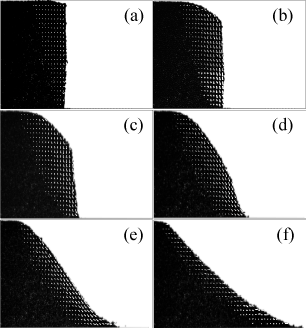
Granular Step Relaxation and Landslides
Saloome Siavoshi and Arshad Kudrolli
Complex Matter and Nonlinear Physics Laboratory, Clark University

The prevalence and danger posed by wall collapse can be noted from the fact that the very next day after our paper was published, a retaining wall collapsed on to the Hudson River Parkway in New York City just before rush hour. The image taken from the New York Times web site shows a similar final profile as in our experiments. A link to the May 13 NYTimes report can be found here
.
 |
|
Figure: A
sequence of the velocity fields of the particles during the relaxation after
the electromagnets are switched off at t = 0 s.
Velocity fields are found by direct particle tracking. (a) t = 0.04 s, (b) t
= 0.085 s, (c) t = 0.125 s, and (d) t = 0.175 s, (e) t = 0.25 s, (f) t =
0.45 s. The direction and length of the vectors corresponds to the velocity
of the particle at that location. Note that the speed of the particles
appear to decrease smoothly with depth, and the depth of flow increases
initially and then decreases. The initial pile is observed to deform rapidly
initially and then comes to rest with the free surface inclined at angle to
the horizontal. It can be noted that the surface is clearly nonlinear at
early times, but appears somewhat linear at the end.
|
We study the gravity driven evolution of a step composed of non-cohesive steel beads using high-speed imaging and particle tracking. Our study is motivated by a desire to gain deeper understanding of rapid failure and relaxation in granular materials. For example, landslides resulting from cliff-side failure and breaking of retaining walls can rapidly release granular materials which can then travel great distances causing destruction in its path. Having an understanding of the nature of the flow has obvious importance. While there have been geophysical studies of such phenomena, a fundamental understanding is still lacking. Modeling is stymied by a lack robust theory for granular flow under conditions where grains can interact over a wide range of time scales. An additional complication is the transient nature of the dynamics. Our approach is to gain a deeper understanding by constructing a model system that can be thoroughly investigated experimentally, and which can be used to test and develop theory.
An experimental innovation is the use of magnetic forces with the help of electromagnets to hold the pile initially and release it with zero initial velocity. The step is released when the current is switched off. We visualize the surface and the motion of the grains throughout the entire relaxation. The initial failure occurs at the surface and the subsequent flow is also confined to the surface as the step relaxes to its final state. The final shape of the surface is almost linear, depends on the initial angle of the step, and is not sensitive to the height of the initial step and the size of the grains. The average final slope of the pile is only slightly lower than the angle of repose of a pile formed by slowly pouring particles on a flat surface. We find that the observed evolution of the step can be described by a BdG convective-diffusion model after a flow dependent variable is introduced.
Publication:
1. Failure of a granular step, S. Siavoshi and A. Kudrolli, Phys. Rev. E 71, 051302 (2005) (6 pages). URL: http://link.aps.org/abstract/PRE/v71/e051302
Contact information:
Arshad Kudrolli
akudrolli@clarku.edu
Updated: May 18, 2005